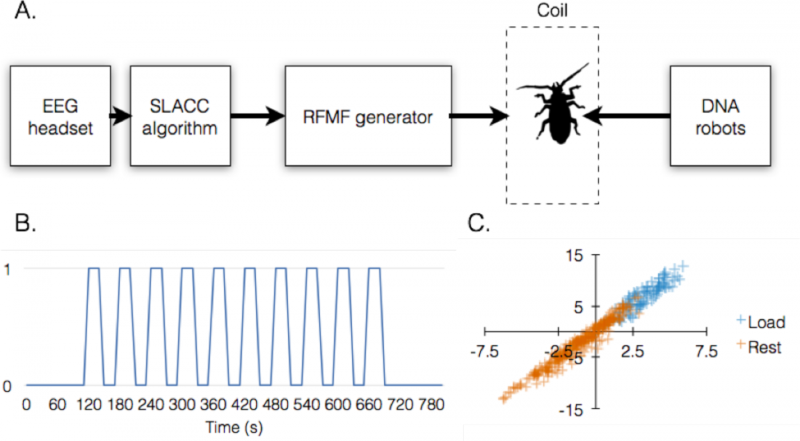August 27, 2016 weblog
Bot tech controls drug release when needed

(Tech Xplore)—A study shows that that nanobots can release drugs inside your brain. The nanorobots, reported New Scientist on Thursday, are built out of DNA. Drugs can be tethered to their shell-like shapes.
Helen Thomson had details on how this all works: "The bots also have a gate, which has a lock made from iron oxide nanoparticles. The lock opens when heated using electromagnetic energy, exposing the drug to the environment. Because the drug remains tethered to the DNA parcel, a body's exposure to the drug can be controlled by closing and opening the gate."
Their study has been published in PLOS ONE, as "Thought-Controlled Nanoscale Robots in a Living Host." New Scientist talked about the value of their work, as showing the ability to exercise more precise control over when a drug is active in the body. "Because the bots can open and close when required, the technology should minimize unwanted side effects."
Therein has been the challenge, getting drugs to where they need to be exactly when they are wanted. "Most drugs diffuse through the blood stream over time – and you're stuck with the side effects until the drug wears off," wrote Thomson.
Kate Baggaley in Popular Science said, "This technology could eventually give people more control over when and where a medication is active in their body." Thomson said the technique may be useful for treating brain disorders such as schizophrenia and ADHD.
"The technology released a drug inside cockroaches in response to the man's brain activity. As described in Popular Science: "A man's brain activity prompted nanobots made out of DNA to release drugs inside a cockroach."
The system is from a team at the Interdisciplinary Center, in Herzliya, and Bar Ilan University, in Ramat Gan, Israel. Following their research effort, the question becomes if and when we will see this applied to humans. According to the New Scientist report, the technology is not ready for use in humans.
They still have to work on the basic setup, including a smaller, more portable way to measure brain activity. New Scientist said they also envision the person wearing an EEG device similar to a small heating aid to monitor brain activity.
What's next? Thomson said that "the technology isn't ready to be used in humans yet. To work, the setup needs a smaller, more portable method of measuring brain activity. The team also envisions a person wearing a small, hearing aid-like EEG device to monitor brain activity and detect when drugs are needed – "for example, when a person with ADHD's concentration begins to lapse. A smart watch would then create the electromagnetic field required to release a dose of Ritalin."
The authors wrote that "so far no interface has been established between a human mind and a therapeutic molecule, which are 10 orders of magnitude apart. The purpose of this study was to show that DNA robots can bridge this gap." They said the robots which they designed can be electronically remote-controlled. "This was done by adding metal nanoparticles to the robotic gates, which could heat in response to an electromagnetic field."
More information: Shachar Arnon et al. Thought-Controlled Nanoscale Robots in a Living Host, PLOS ONE (2016). DOI: 10.1371/journal.pone.0161227
Abstract
We report a new type of brain-machine interface enabling a human operator to control nanometer-size robots inside a living animal by brain activity. Recorded EEG patterns are recognized online by an algorithm, which in turn controls the state of an electromagnetic field. The field induces the local heating of billions of mechanically-actuating DNA origami robots tethered to metal nanoparticles, leading to their reversible activation and subsequent exposure of a bioactive payload. As a proof of principle we demonstrate activation of DNA robots to cause a cellular effect inside the insect Blaberus discoidalis, by a cognitively straining task. This technology enables the online switching of a bioactive molecule on and off in response to a subject's cognitive state, with potential implications to therapeutic control in disorders such as schizophrenia, depression, and attention deficits, which are among the most challenging conditions to diagnose and treat.
© 2016 Tech Xplore


















